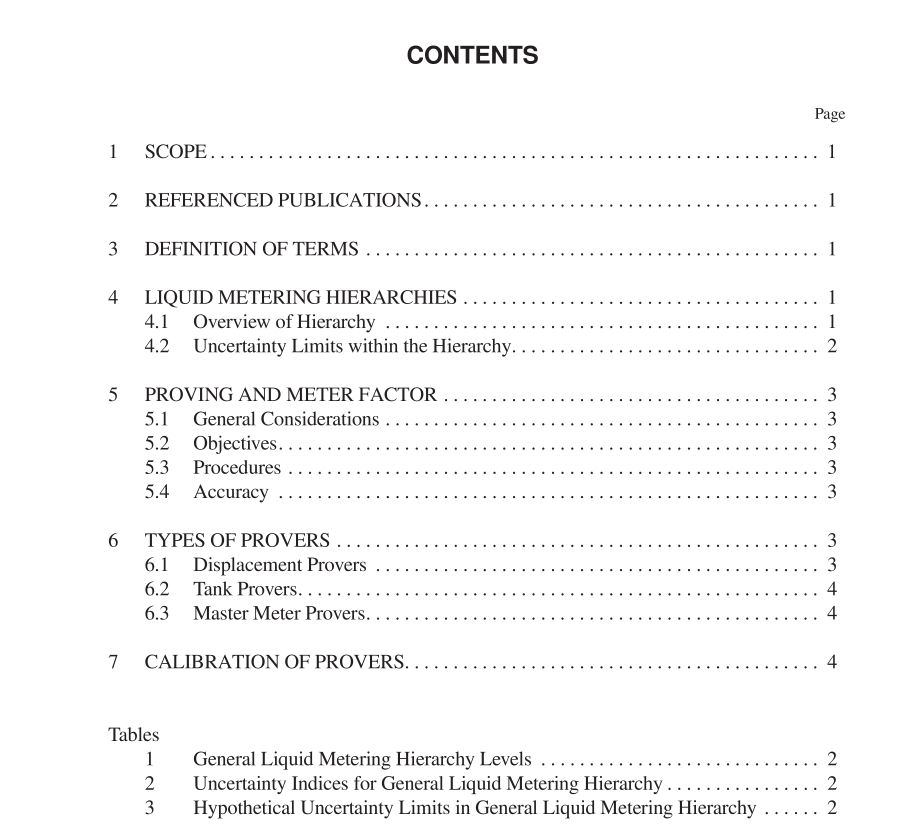API MPMS 4.1 pdf download

API MPMS 4.1 pdf download.Manual of Petroleum Measurement Standards Chapter 4—Proving Systems
4.2 UNCERTAINTY LIMITS WITHIN THE HIERARCHY
Each level within a hierarchy will include all the errors and uncertainties from the previous or higher levels of the hierar- chy. Therefore, uncertainties will always increase throughout each level of the hierarchy. Exact, defined, and rigorous pro- cedures must be developed and followed exactly through each level of a hierarchy so that the uncertainty in the final level of the hierarchy is not higher than specified and still tol- erable for commercial purposes. For levels in the hierarchy that exhibit randomness because of the intrinsic random nature of the activity or equipment, error or uncertainty may be limited to twice or less than the uncertainty in the previous level. For levels that are performed infrequently in the hierar- chy, such as primary standards, the next level in the hierarchy, such as secondary working standards, may have uncertainty limits that are up to four times the previous level in the hierar- chy. In the general hierarchy shown in Table 2, uncertainty indices are used to indicate the ratio of uncertainty of one level compared to the primary standard. The effects of time should also be included in establishing limits within a hierarchy. Most custody transfer contracts or arrangements are in effect for years between two or more par- ties; therefore, the effects of random uncertainties to propa- gate to lower average values with time should be considered. Frequently, repeated activities may have uncertainty limits that are closer to the adjacent level in the hierarchy if rigorous procedures are developed and implemented that minimize additional uncertainties. In the hierarchy of Table 2, the uncertainty index for meter indicated volume and corrections for quantity, such as the meter factors, can be lower than indi- cated in Table 2. An uncertainty index of 16 – 24 or lower for meter indicated volume is obtainable over the period of a year or longer. A lower uncertainty index over time for the custody transfer ticket of 32 – 48 is also obtainable from rigorous and frequently performed activities. If the uncertainty limit for the average of custody transfer over one year is prescribed as ± 0.10%, the possible hypothet- ical corresponding uncertainty limits for each of the levels in the hierarchy are presented in Table 3. Within each of the hierarchy levels there are other activities that are sources of error that must be identified and limited so that they do not disrupt the integrity of the hierarchy. These activities include procedures for calibrating the secondary working standards, field transfer standards, and meter prov- ers. Rigorous procedures must be developed and followed so that these additional sources of uncertainties do not disrupt the uncertainty control within the hierarchy.
5.1 GENERAL CONSIDERATIONS
All meters should be proved with the liquid to be measured and at the operating flow rate, pressure, and temperature. A meter that is used to measure several different liquids should be proved with each liquid. For additional details see API MPMS Ch. 4.8. Meter proving shall be performed with a high degree of pre- cision. The many details of the meter, its auxiliary equipment, and the proving system can contribute to measurement uncer- tainty. Likewise, there are difficulties in determining the physi- cal properties of the measured liquid, pressure, temperature, and the presence of trapped air. Thorough inspections of prov- ers and their components should be made routinely to ensure the reproducibility of proving results. See API MPMS Ch. 12 and API MPMS Ch. 13 for applicable calculation methods.









